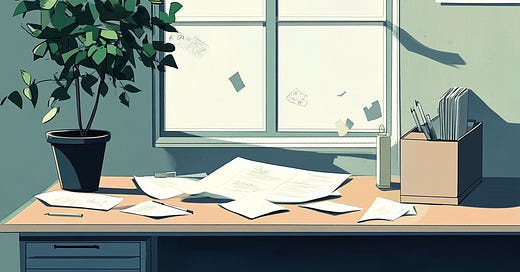Manager's Toolkit #4: "The Burnout Prevention Protocol: Spotting Warning Signs Before Crisis Hits"
How to keep your team from hitting the wall before they even see it coming
We’ve all seen it happen (if you haven’t, you probably have, just not noticed). A star performer gradually loses their spark. Work quality slips. They start missing deadlines. Then one day, they're handing in their notice or signed off with stress.
Burnout doesn't arrive overnight. It creeps in slowly with warning signs we often miss until it's too late.
As people pros and HR folk, we have a sharp responsibility to spot these warnings early – not just to keep productivity up (although it’s a real concern), but because we should genuinely care about our colleagues' mental health and wellbeing.
Here's how to create your burnout prevention protocol:
Watch for the subtle shifts
Burnout (the scumbag) reveals itself through subtle changes in behaviour and work patterns that can sometimes be easy to miss, but here’s the kinds of things you can be looking out for:
The always-on becomes unavailable. Someone who always responds promptly now takes days to answer messages, or not at all and need more prompting.
The perfectionist submits sloppy work. Attention to detail vanishes. Small, hidden errors creep in, or sometimes, big hoary errors that you wonder ‘How did you miss that?
The meeting contributor goes silent. Usually gregarious and outspoken colleagues, stop engaging in discussions.
The cheerful one turns cynical. Every suggestion is met with "what's the point?" (or similar).
The reliable one starts missing deadlines. Their calendar management falls apart. They’re late, or no shows for recurring meetings, or worse, client calls.
None of these alone proves burnout. But a pattern of changes warrants attention.
Create check-in rituals that matter
Many managers ask "how are you?" without actually listening for the answer. Create meaningful check-ins that can actually help you understand how people are feeling:
Start one-to-ones with "what's your energy level today, from 1-10?" Track these numbers over time.
Ask "what's draining you most right now?" rather than generic questions.
Notice when someone says "I'm fine" but their body language screams otherwise. No one, really, is fine (gestures wildly about).
Create team rituals where people share both victories and challenges.
The key is consistency. Brief, regular check-ins beat lengthy quarterly ones and you’re much more likely to get the info you need with more timely chats.
Look at your systems, not just your people
Often burnout isn't about individual resilience – it's your systems that need fixing.
Audit after-hours communication. Is your team messaging each other at 10pm? That's a system issue. No one should be working at 10pm! Unless you work shifts, then that’s OK.
Track leave patterns. Are people banking holidays rather than taking them? That needs addressing before they take the longest, unending holiday they’ve ever had.
Monitor workloads objectively. Don't take "I can handle it" at face value if someone's working weekends, or light nights, or their work quality is suffering.
Examine meeting loads. Could that 60-minute meeting be a 15-minute one or an email? Or, you know, not happening at all?
Build recovery into work, not around it
We often treat recovery as something that happens outside work. "Take a holiday" isn't the answer when someone's drowning in work, requests and fending off advances from Peter in sales.
Build recovery into normal working patterns:
Create meeting-free days or afternoons.
Encourage proper lunch breaks away from desks.
Normalise saying "I need to push this deadline" when appropriate.
Allow flexible working when people need it most.
Make it acceptable to block focus time in calendars.
When you spot the warning signs
If you notice burnout warning signs, and now you’ve read this email, you should be fired up to notice them, act promptly:
Have a private, non-judgmental conversation. "I've noticed changes in your work pattern. I'm concerned about your wellbeing."
Listen more than you talk. You have two ears and one gob-hole for a reason. Ask open questions and resist offering solutions immediately.
Discuss immediate pressure relief. Can deadlines be adjusted? Tasks delegated? Priorities clarified?
Connect them with proper support. Your company's employee assistance programme, occupational health, or external resources.
Follow up consistently. One conversation isn't enough. Neither it two. Make it a regular thing.
Prevention matters most
The best burnout protocol prevents issues before they start, then you won’t have to watch for signs of it as it just can’t happen:
Review job design regularly. Has scope crept without resources increasing?
Train managers to recognise burnout signs. (Tip: forward them this email)
Create a culture where "I'm struggling" isn't career-limiting, but a sign of maturity.
Model healthy boundaries yourself.
Ultimately, burnout prevention isn't about keeping people working (ok, it is a little bit). It's actually about treating humans like humans, not resources to be optimised or cogs to be greased and eventually replaced.
When we create workplaces where people can thrive without burning out, increased productivity and retention follow naturally. It’s not rocket science. But that's just a happy side effect of doing the right thing.
What burnout warning signs have you spotted in your team recently? And more importantly – what are you doing about them?




